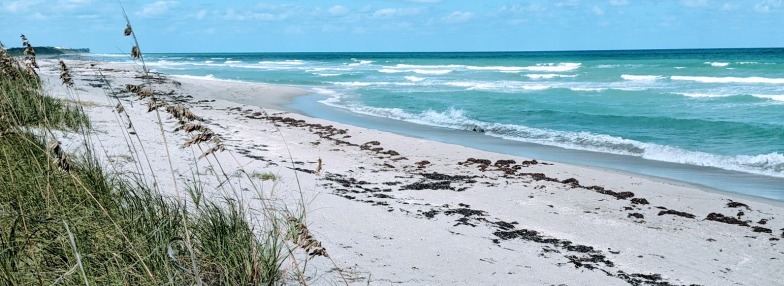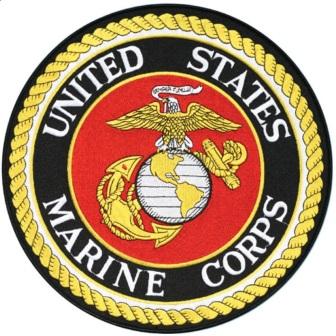I am proud to be a U.S. Marine and Viet Nam veteran
After hearing many stories from my uncle James (Jimmy) Hazearl Ellis, who was a Marine and saw action in the Pacific during WW II, I knew I was going to be a Marine also.
Detailed official declassified reports for the period I was in the 1st Battalion, 26 Marines are posted below.
2016 was a special year for me in that it was the 50th anniversary of me going to Viet Nam for my 13 months tour of duty. Even though many years have passed, the special memories have not. My Viet Nam experience started with the formation of the 1/26 at Camp Pendleton, CA. Hundreds of Marines from across the country were reporting to temporary holding units. Each of us was mystified about a unit without any agenda; we didn't know what existed in planning was about to become a reality. Then orders started coming in: report to the 1st Battalion, 26 Marines. The 26th Marine Regiment was deactivated after WWII and reactivated March 1, 1966. No one knew anyone else when the ranks were populated, and at that same time, no one could imagine how intimate our relationships would become in Viet Nam. I've never seen so much new equipment. Back in Camp Lejeune everything was well worn; the vehicles were from the Korean era and maybe even WWII vintage. As soon as the companies were formed, we began training. Camp Pendleton is a massive place, war games can go on all week and no one on other parts of the base even know it. Finally the day came to leave for Viet Nam. On August 2, 1966, the entire battalion left Pendleton for San Diego where three ships were waiting: The USS Iwo Jima LPH-2, (Landing Platform Helicopter), the ship I was on; the USS Vancouver LPD-2 (Amphibious Transport Dock); and USS Thomaston LSD-28 (Dock Landing Ship). The Iwo was an amphibious assault ship—a dedicated helicopter carrier for vertical assaults and support once we were deployed. Like all big war ships of its day, it was a self-contained city. A densely populated one. The only privacy you had was in your dreams when you were in a deep sleep. Pearl Harbor, Hawaii, was our first stop. We never knew what the Navy was doing but they were always busy. We guessed getting fuel, armaments for us, and whatever else ships need. Our job on the ship was to stay out of the way, and that was hard. We were up at 4 AM, before ships reveille, to do PT on the flight deck, run up and down stairwells, and anything else to exercise. Just to keep things interesting on the ship, a sweepstake was designed to award a cash prize to the person who held the ticket with the closest time to when the ship was completely moored. My friend Smitty, a bush pilot from Alaska, and I were coming back from the mess hall when we passed the ticket sales. He asked if we should by a ticket. I rarely gamble so I said no, but he went over anyway and bought two tickets. One for me and one for him. I paid for mine and thanked him. When moored, a time was given as an official notice over the PA system, I guess for the ship's record, to us it was meaningless—except this time, I won. The first day in port, I was assigned (stay-busy) guard duty, keeping the seagulls off the deck I think. Then I heard over the PA system my name announced as the winner of the sweepstake—$180.00. Unable to leave the ship, I had to wait until the following day to enjoy my winnings. The next day, completely out of character for me, I rented a nice hotel room in Honolulu for four days. I invited my friends to come and use it and the pool when they were off duty. We were rotating duty on ship so everyone would come and go as they pleased. I never regretted this carefree spending because this was our last sense of normality for thirteen months. From this point on, there wasn't much opportunity to spend money, so it had little meaning to us. Payday was monthly and the paymaster would ask how much do we want, the rest was left on the books. I remember once when I was in Viet Nam I had twenty dollars in MPCs when asked how much do I want. Since this was the same twenty dollars I had last payday, I chose to receive none. MPCs, military payment certificates, were distributed instead of American dollars. After Pearl Harbor, the USS Iwo Jima cruised by the island of Iwo Jima to give us a close-up view of the WWII hard-fought for island where the 1/26 participated and because of it being the namesake of our ship. Iwo Jima is four and one-half miles long by two and one-half miles wide. It is punctuated on the southwestern end by Mt. Suribachi, which is the location of one of the most inspiring battles of WWII. Marines, after winning the battle for the mountain, spontaneously raised a small American flag, which was later replace with a much larger one. The United States Marine Corps War Memorial solidified that event in Marine Corps history forever. Naval chaplain Roland Gittelsohn's Iwo Jima Eulogy is as meaningful today as then. We stopped in Okinawa to drop off our nonessential clothing and to enjoy a couple of days of liberty. At this time we had two seabags, one for Viet Nam and the other holding everything not related to combat. After Okinawa, our next port was the navy's base at Subic Bay, Philippines. In the neighboring city of Olongapo, we had some very entertaining liberty. Many hours were spent trying to recover from the night before and wondering what kind of meat we ate from the charcoal grills that lined the sidewalk—it was sold as monkey meat, but, oh well. Tradition, words, and some idioms have a long life. In the book Fix Bayonets by John W. Thomason Jr. (originally published 1926), "Monkey-Meat" was mentioned by the 2nd Marine Division in WW I as Argentine beef with carrots in it—a French ration. Training for Viet Nam continued and became more specialized. We had three FAC (forward air control) teams for the battalion. Four members were in each team led by a Marine pilot—I was in one team. The three teams would rotate among the four infantry companies and HQ company, where one was always required. We stayed busy. On one training exercise we were taken by chopper with some Filipino Marines to a remote island. For a couple of days, we called in air strikes that unmercifully bombed and strafed mother nature, lived in the jungle, bathed in a creek, and ate C-rations. Of course there was time for swimming and practical jokes. Practice and liberty were over—It was time to hit the beach in Viet Nam. Our first operation began August 16 at 9 am with a joint surface-borne and helicopter-borne assault. Some Marines were choppered in while others left the ship over the side. They climbed down the nets and got into landing craft for that anxious trip to the beach. I left over the side. I distinctly remember my first thoughts when the boat's ramp went down on the beach and I entered into the theater of combat for the first time: I hope no one will be shooting at us, remember to jump off the side of the ramp as trained, and later, why the hell did they land us at the wrong location. You jump off the side of the down ramp because if you run off the front there is the possibility of a wave pushing the landing craft forward and crushing you. We had to hike five miles up the beach to our designated landing area. I heard "war is hell," but walking five miles on a beach in South Viet Nam, with an M-14 rifle, two canteens, five loaded magazines, radio, and pack (close to eighty pounds of equipment) has to be next door. We were issued new M-14s on the ship coming over but they were replace with M-16s about four months later when we were on Hill 55. We made additional helicopter-borne assaults into Viet Nam hot spots while the ships waited off shore in support. I'm unaware of additional combat landings that consisted of climbing down the nets into the landing craft and landing on the beach. The landing craft operation I was on was the first and last for us—and maybe for the Marine Corps. After our first landing and combat operation, we made three or four more before September 26, when we disembarked the ships for the last time in Da Nang for a permanent location at Hill 55. At Hill 55, we were to help defend the air base in Da Nang by not letting the enemy in or through our area of operation. The line companies were set out around the hill running regular patrols and S&Ds (Search and Destroy missions). On May 5, 1967, 1/26 relocated to Phu Bai and later, Khe Sanh. Khe Sanh was our farthest northwestern outpost in South Viet Nam. The ever present Hills 881 N., 881 S., and 861, four miles northwest, were overlooking Laos and, somewhere in the jungle, the Ho Chi Minh Trail. At Hill 55, the 1st Battalion, 26th Marines received orders to move to Phu Bai. Preparations began May 3 and 4; the airlift commenced May 5 and was completed May 6. The Phu Bai area of operation was short lived and followed by another move to Khe Sanh. This airlift commenced and was completed May 11. Two battalions with the 3rd Marines, exhausted from a hard fight with the NVA on hills 861, 881 S and 881 N, were replaced with the 1/26. During this period of relocating, I was enjoying my R&R in Bangkok. What a surprise I had when I got back to Hill 55. I found strange faces and the 1st Battalion, 7th Marines in place with no trace of my 1/26. I dutifully checked in with the 1st Battalion, 7th Marines CP, picked up my new "jungles" (clothing specially designed for Viet Nam), M16, ammunition, and all of the other gear we hauled around that became a permanent part of our life. As a transient I had no duties; and I'm sure the commanding officer had his hands full with his new assignment that I wasn't given much thought—my placement was at the bottom of his to-do list. This free time was appreciated at first but boring after a few days. Five days later my orders were to find and rejoin the 1/26. Finding it was a different story—I was on my own. There were no road maps and a war was going on. I first headed to Da Nang, which was a transportation hub, and then to Phu Bai. When I got to Phu Bai, I learned the 1/26 had again moved to Khe Sanh. Now I was off to Khe Sanh. Traveling was very easy, outside the dangers of a war. No written orders were necessary, just show up, find out where a plane, helicopter or river boat was going, and if they had room you hopped on. I had a very interesting tour of the country trying to find the 1/26. When I finally rejoined the 1/26 in Khe Sanh, my friends told me they thought I stayed in Bangkok and gave up on the war. My company commander had little interest in my confusing journey—it was back to routine radio watches and S&Ds. It was a big disappointment when I discovered my camera and pictures didn't make the trip. I had been taking pictures from the time on the USS Iwo Jima until R&R. I never saw them again and realized I should have been sending them home instead of keeping them. Take a safe trip to Khe Sanh to see what was going on. Two books accurately describing Khe Sanh around this time and after I left are Dispatches by Michael Herr and Last Stand at Khe Sanh by Gregg Jones. During the 13 months, our three FAC teams (total of twelve people) lost one killed in action, FAC team leader and pilot, Lieutenant Dennis Bradley, and one wounded in action, my good friend PFC Don Hummel (online obit link). A bookmark I made from some of his artwork. My thirteen-month tour was up and it was time to go home. Since we all began our tour at the same time, we were due to leave at the same time, but we had many replacements due to transfers, attrition, and some volunteered for another thirteen-months tour. Returning home from combat was different then than now. I couldn't believe I was still going on S&Ds just days before I left for home. I was on my last S&D thinking how many times can you win in a row rolling the dice—I was too short for this exposure. The next day my orders came: catch a supply chopper and return to the CP on Khe Sanh. I was at an outpost on Hill 861, a few miles northwest of Khe Sanh (the other FAC team was on Hill 881S). At the main Khe Sanh air base and CP I started three days of check out (preparation to leave), the fourth day I flew to Da Nang, the fifth day I flew by commercial aircraft to Tokyo, the sixth day I flew to Seattle, WA., where I made connecting flights to fly home to Birmingham, AL. I arrived home on the 7th day. From combat S&Ds to Birmingham in seven days! When I saw my mother, I realized how much she worried. Everything that could have happened to me was written in her face. However, with each following day, a feature of that expression was erased, and I slowly entered normality. The war was over—for me. The Viet Nam war was an unpopular war, and anger from Americans was directed not only at the politicians but at the military personnel who participated in it. When we returned home, we weren't heroes but unappreciated war veterans. However, each of us understood something that any nonparticipant could never conceive. We shared the same thoughts and actions: tolerating what each day threw at us, staying alive and looking out for each other, enjoying a type of camaraderie that could exist nowhere else in the world, and going home. Abstractions such as the flag, protecting freedom, preventing the spread of communism, and defending America was a hard concept to find. Rarely a day goes by without me acknowledging how grateful I am for the many years I've enjoyed after this war while some friends and so many others never came back alive. I won a second time in thirteen months: the inexplicable lottery of war. Semper Fi! Pictures exchanged at a reunion, fifty-seven years later. Reports: August 1966 September 1966 October 1966 November 1966 December 1966 January 1967 February 1967 March 1967 April 1967 May 1967 June 1967 July 1967 August 1967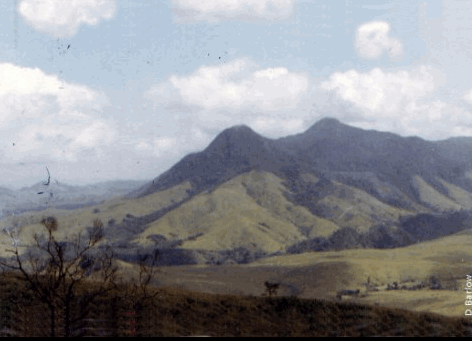 This picture is of hills 881 North and 881 South, 4 miles northwest of Khe Sanh Combat Base.
They were an ever-present site from
just about anywhere around the area. Hill 861, just east of 881 N and S,
was where the NVA, at 20,000 strong, attacked;
this began the long battle for Khe Sanh Combat Base with only 6,000 defenders.
This picture is of hills 881 North and 881 South, 4 miles northwest of Khe Sanh Combat Base.
They were an ever-present site from
just about anywhere around the area. Hill 861, just east of 881 N and S,
was where the NVA, at 20,000 strong, attacked;
this began the long battle for Khe Sanh Combat Base with only 6,000 defenders.
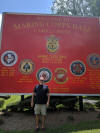 On
a two-week summer trip in August 2019, my wife and I were close to
Jacksonville, NC, so I couldn't resist returning to my old base at Camp
Lejeune and seeing the liberty town of J-ville. The Marine MP at the
entrance gate told me there were no visitors allowed, so we
couldn't get in. I told him,"That's alright, I spent 4 years waiting to
get out, I don't need to go back in." He said I know what you mean. We
turned around and my wife took this picture at the entrance.
On
a two-week summer trip in August 2019, my wife and I were close to
Jacksonville, NC, so I couldn't resist returning to my old base at Camp
Lejeune and seeing the liberty town of J-ville. The Marine MP at the
entrance gate told me there were no visitors allowed, so we
couldn't get in. I told him,"That's alright, I spent 4 years waiting to
get out, I don't need to go back in." He said I know what you mean. We
turned around and my wife took this picture at the entrance.
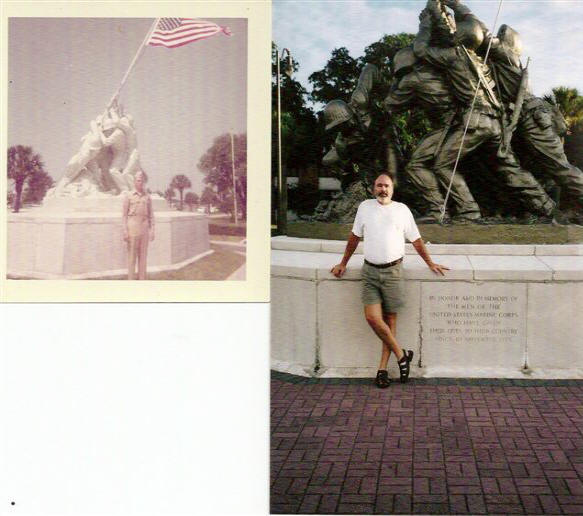 Parris Island May 31, 1964, just after completion of boot
camp and at
the same location 36 years later.
Me in the fall of 1964 at Camp Lejeune.
Parris Island May 31, 1964, just after completion of boot
camp and at
the same location 36 years later.
Me in the fall of 1964 at Camp Lejeune.
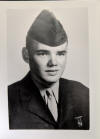
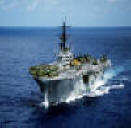 (L to R) August 1966, our first landing and combat operation in Vietnam, Deckhouse III, others followed
into September. It was an Amphibious and Helicopter-borne attack directed
at the NVA (North Vietnamese Army) just south of the DMZ. Third day in
was hard with difficulty getting resupplied, this helicopter was shot
down attempting a drop. The ship I was on, USS Iwo Jima, that took us
from San Diego, Hawaii, the Philippines, Okinawa, cruise by the Island of
Iwo Jima, landing operations in Viet Nam and our final disembarkation in Da Nang,
Viet Nam. Ten days after our first landing we did (and received) some damage: Enemy KIA 254 confirmed (313
probable); Friendly KIA 34, WIA 167.
An enlightening documentary about
Con Thien that tells a lot about
everyday life around the DMZ in Vietnam.
(L to R) August 1966, our first landing and combat operation in Vietnam, Deckhouse III, others followed
into September. It was an Amphibious and Helicopter-borne attack directed
at the NVA (North Vietnamese Army) just south of the DMZ. Third day in
was hard with difficulty getting resupplied, this helicopter was shot
down attempting a drop. The ship I was on, USS Iwo Jima, that took us
from San Diego, Hawaii, the Philippines, Okinawa, cruise by the Island of
Iwo Jima, landing operations in Viet Nam and our final disembarkation in Da Nang,
Viet Nam. Ten days after our first landing we did (and received) some damage: Enemy KIA 254 confirmed (313
probable); Friendly KIA 34, WIA 167.
An enlightening documentary about
Con Thien that tells a lot about
everyday life around the DMZ in Vietnam.
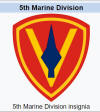 This
is the insignia of the 5th Marine Division. It can be seen in
documentaries of Iwo Jima during WWII and on the memorial atop Mt. Suribachi where the flag was raised. It is imprinted on my lighter
below.
This
is the insignia of the 5th Marine Division. It can be seen in
documentaries of Iwo Jima during WWII and on the memorial atop Mt. Suribachi where the flag was raised. It is imprinted on my lighter
below.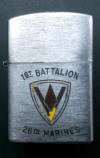 After
many months in Viet Nam, everyone that originally formed the 1/26 at
Camp Pendleton was given a lighter. This is mine
that I still have.
After
many months in Viet Nam, everyone that originally formed the 1/26 at
Camp Pendleton was given a lighter. This is mine
that I still have.
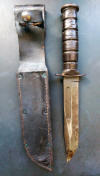 This
is my KA-BAR. I carried it on my cartridge belt on the right rear hip
between one of my canteens and magazine pouches. After using and
carrying it everyday for 13 months I couldn't part with it—so it came
home with me.
This
is my KA-BAR. I carried it on my cartridge belt on the right rear hip
between one of my canteens and magazine pouches. After using and
carrying it everyday for 13 months I couldn't part with it—so it came
home with me.
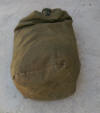 My
seabag, issued in 1964, carried my clothing and gear halfway around the
world—and back. In 2016, after 52 years, it was time to say goodbye to
it and the contents: my original
uniforms and Viet Nam "Jungles." "Jungles" was our nickname for the specially
designed greenish-brown clothing for Viet Nam. The thin-cotton trousers
had deep cargo pockets along with the normal two in the rear and side
pockets. There was a draw string at the bottom of each leg for
tightening the material to prevent anything from crawling up. The shirt
had over-sized pockets and was worn outside of the trousers; it was
made from the same thin cotton, for fast drying, like the trousers.
My
seabag, issued in 1964, carried my clothing and gear halfway around the
world—and back. In 2016, after 52 years, it was time to say goodbye to
it and the contents: my original
uniforms and Viet Nam "Jungles." "Jungles" was our nickname for the specially
designed greenish-brown clothing for Viet Nam. The thin-cotton trousers
had deep cargo pockets along with the normal two in the rear and side
pockets. There was a draw string at the bottom of each leg for
tightening the material to prevent anything from crawling up. The shirt
had over-sized pockets and was worn outside of the trousers; it was
made from the same thin cotton, for fast drying, like the trousers.

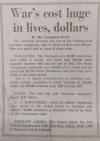 This is what we all dreamed of, and the designated cost; however, the real cost
is known only to those who were there.
My mother clipped and saved all articles from the paper when they were
about the 1/26. Here are a couple.
She also clipped a full page size map of Viet Nam so she could keep up
with our operations.
This is what we all dreamed of, and the designated cost; however, the real cost
is known only to those who were there.
My mother clipped and saved all articles from the paper when they were
about the 1/26. Here are a couple.
She also clipped a full page size map of Viet Nam so she could keep up
with our operations.
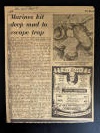
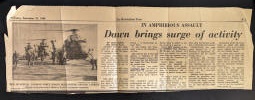
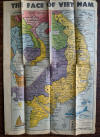 One b
One b ig surprise I never expected was when my mother gave me, 36 years
after my return from Viet Nam, every letter I wrote home. Until that
time I never knew she saved them.
There was no postage on outbound mail.
ig surprise I never expected was when my mother gave me, 36 years
after my return from Viet Nam, every letter I wrote home. Until that
time I never knew she saved them.
There was no postage on outbound mail.
 Dog
tag.
Dog
tag.
